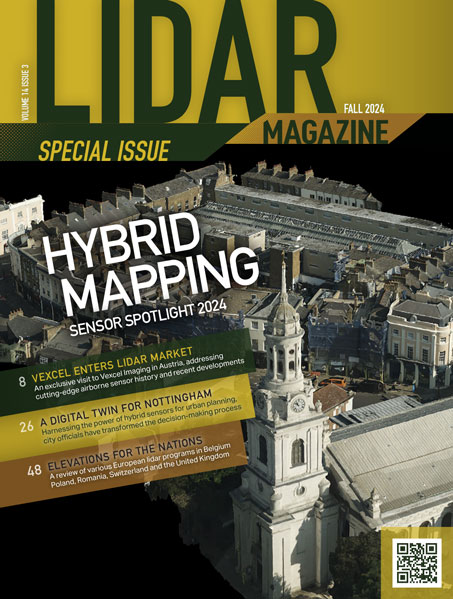Nottingham, UK, 11 September 2014 – A handheld mobile laser scanner is helping researchers in New Zealand develop new working practices to characterise forest stands for management and research purposes. The team at Scion, a New Zealand Crown Research Institute (CRI), required a practical means for accurately locating and measuring individual trees on the ground. Using the ZEB1 they achieved significant advantages in speed of data capture, quality of the resulting point cloud and ease of use of the system. Scion purchased the ZEB1 from 3D Laser Mapping, following successful trials of the technology.
Traditionally poor GPS under forest cover makes identifying trees a problem, commented David Pont of Scion, an award winning scientist who specialises in world leading research to identify individual trees from remotely sensed aerial LiDAR. The ability of the ZEB1 to provide the position for spatial locations using SLAM technology specifically developed for mapping of areas with no GPS was therefore of immediate interest to us.
3D Laser Mapping successfully trialled the ZEB1, scanning small stands of trees close to the Scion campus in Rotorua, New Zealand. Within hours the team were back in the office viewing a highly detailed point cloud of the trees. Having subsequently purchased their own ZEB1, researchers at Scion are now carrying out further trials of the system including the scanning of inventory plots used to characterise forest stands for management purposes. The project team aims to extract tree diameters, locations and stem shapes from the ZEB1 point clouds rather than through the use of conventional manual measurements.
Besides portability and ease of use the ZEB1 really shines in the speed of scanning, continued Pont. In the forest, trees are obscured by terrain, undergrowth and even other trees and conventional tripod units require multiple scans and registration of the point cloud to cover any significant area. The ZEB1 scans continuously as you move around the forest to provide a single, registered point cloud.
It is this ability to scan as you move that lifts the use of the ZEB1 from an academic exercise to something that demonstrates real potential for practical applications in forestry. In fact, the old adage cant see the wood for the trees, is possibly, with the use of the ZEB1, no longer the case!
Pont concluded, The ZEB1 and its software are both remarkably easy to operate and from the first enquiry to the current phase of practical trials the support from 3D Laser Mapping has been excellent.
CONTACTS:
Editorial enquiries to robert@market-it.co.uk, +44 (0)1666 823306
Reader and advertising enquiries to Natasher.Beecher@ 3dlasermapping.com, +44 (0)1949 838 004
Colour separation requests to robert@market-it.co.uk
www.3dlasermapping.com
Notes to Editors:
ZEB1 uses robotic technology called Simultaneous Localisation and Mapping (SLAM). The ZEB1 system includes a lightweight laser scanner mounted on a simple spring mechanism, which continuously scans as the operator walks through the environment. As the scanner loosely oscillates about the spring it produces a rotation that converts 2D laser measurements into 3D fields of view. Its ability to self-localise makes ZEB1 ideally suited for use indoors, underground and in other covered environments, where traditional solutions that utilise GPS dont function well.
ZEB1 was developed by CSIRO, Australias national science agency, and is licenced to GeoSLAM (a UK based start-up company). The competitively priced ZEB1, now exclusively available from 3D Laser Mapping, allows for fast data capture without any complex set up. ZEB1 is easy to use, truly portable and does not require expensive software or high end computers to process the captured data.
3D Laser Mapping is a global developer of laser scanning solutions for sectors such as mapping, mining and manufacturing. 3D Laser Mapping specialises in integrating laser scanning hardware with their own software and peripherals to create solutions at the cutting edge of technology. Through a worldwide network of distributors 3D Laser Mapping is able to provide frontline support and service for a growing international client base. For further information see www.3dlasermapping.com
CSIRO, the Commonwealth Scientific and Industrial Research Organisation, is Australia’s national science agency and one of the largest and most diverse research agencies in the world. CSIRO works with leading scientific organisations around the world, and is recognised internationally for the quality of its research. CSIRO’s research is performed by the 11 Divisions, which are the business units of CSIRO. CSIRO is one of the largest and most diverse scientific institutions in the world with more than 6500 staff located across 56 sites throughout Australia and overseas. For further information see www.csiro.au
CSIROs Digital Productivity and Services Flagship is a $48 million research initiative targeting productivity growth in Australia through frontier services innovation and by unlocking the value of a national broadband infrastructure. Through its research the flagship will help add value to the Australian economy by developing and delivering more efficient and innovative services that improve peoples wellbeing and prosperity. For further information see www.csiro.au/dpas
LiDAR or Light Detection and Ranging the use of aircraft mounted lasers to accurately measure distances between the sensor and object of interest.
Scion is a New Zealand Crown Research Institute (CRI) that specialises in research, science and technology development for the forestry, wood product and wood-derived materials and other biomaterial sectors. Its purpose is to drive innovation and growth from these sectors to build economic value and contribute to beneficial environmental and social outcomes for New Zealand. For further information see www.scionresearch.com
